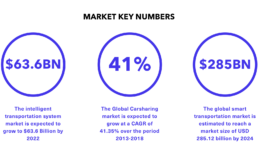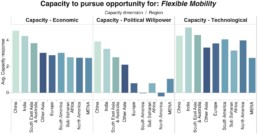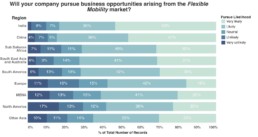A value shift is emerging, changing preferences from owning to sharing of assets in a resource strained world. Vehicles are the symbol of the old ideal of ownership, but people are now increasingly demanding the most efficient and least polluting mobility option.
Getting from A to B should be easy and efficient. It should give us time to prepare for work, to unwind after a day at the office or simply to enjoy the ride.
Most rides are not that way today. Rapid urbanization is hampering the free movement of people and goods. Congested roads are reducing mobility, and when cars are queuing, air pollution rises, but a flexible system integrating all transport modes can alleviate this pressure. Advances in sensor and communication technology along with innovative business models create the opportunity for a paradigm shift in transportation. We do not need to own a car, a bike, or even a frequent traveler pass. We can purchase mobility as a flexible service adjusted to our preferences, the weather, and our agenda for the day. If the weather is nice in the morning, you might want to ride a bike to the office, but when you go home, you need to pick up the groceries, so you choose a car. It may sound futuristic, but the technology and the business models are sprouting.

Replace Products with a Flexible Service
A flexible transport system aims to provide flexibility in choosing routes, travel times, forms of transport, and service providers, while today many people’s daily transport choices are being governed by previous investments in, for example, a car. The opportunity is a new way of looking at transport, by replacing a product with a service. This eliminates the need for owning a car by providing citizens with the means of transport where and when needed. A flexible transport system aims to provide flexibility in choosing routes, travel times, forms of transport and service provider. It is mobility as a service. By subscribing to a flexible service, the users can have access to public transportation, car-sharing, car rentals, bike sharing, and taxi services. The exact mixture of services offered will depend on the actual setting with respect to e.g. geography, climate, population density, and financial capacity of the user.
Coordination and integration of all available forms of transport means less waiting time. Utilizing open data to develop new transport applications to coordinate transport across different types of transport holds great economic benefits. London estimates show that real time mobile transport applications can save society 22 to 88 million USD every year.
By greatly reducing the need for upfront investments in, for example, a car, a flexible service-centered system can potentially increase the mobility of people with low incomes by allowing them access to a greater commuting range, which can translate into upward social mobility.
New Forms of Public-Private Collaboration
To develop this opportunity, private-public partnerships are essential. Public transport is the most efficient means of transport when the demand is particularly high between fixed destinations and, although services can be privately run, public planning is often essential when laying out routes, infrastructure, billing zones etc. However, when demand is low, it is not resource-efficient to drive large, half-empty busses rendering car-sharing, taxi or bicycles options more appropriate. Therefore, developing a truly flexible mobility system will inspire new forms of collaboration between public and public operators to provide mobility for all at all times. It may seem as a daunting task but the benefits for people, the public, and the private companies that manage this feat will be substantial. Mobility for all by integrating and connecting the entire transport system can reduce the need for car ownership in urban areas and thereby reduce emissions.
Survey Findings
Flexible mobility is a popular market opportunity to address transport emissions according to the answers from our global survey in 2015. In particular, it has been well received by young people below the age of 30. This may be an indication of the emerging value shift among younger generations from owning to sharing.

It is the governmental and the financial sector that perceive themselves to be most affected by this opportunity. With respect to pursuing the opportunity, the finance sector is also the most likely of the five sectors surveyed to act on it. The 2015 survey findings point to the fact that the governmental sector is ready to pursue transport-related market opportunities.

There is great variation across regions in terms of the perceived benefits to society from making transport flexible. For Other Asia and South America, flexible transport is perceived to offer great benefits to society whereas in Sub Saharan Africa, leaders see limited capacity to pursue this opportunity. In general, this opportunity is perceived to have a higher potential for society in the high HDI countries than in the medium HDI countries surveyed.
This market was surveyed globally in 2015 by more than 5500 leaders from both the public and private sectors. The survey was conducted in collaboration with the research company YouGov. The survey results were originally published in the Global Opportunity Report 2016.

